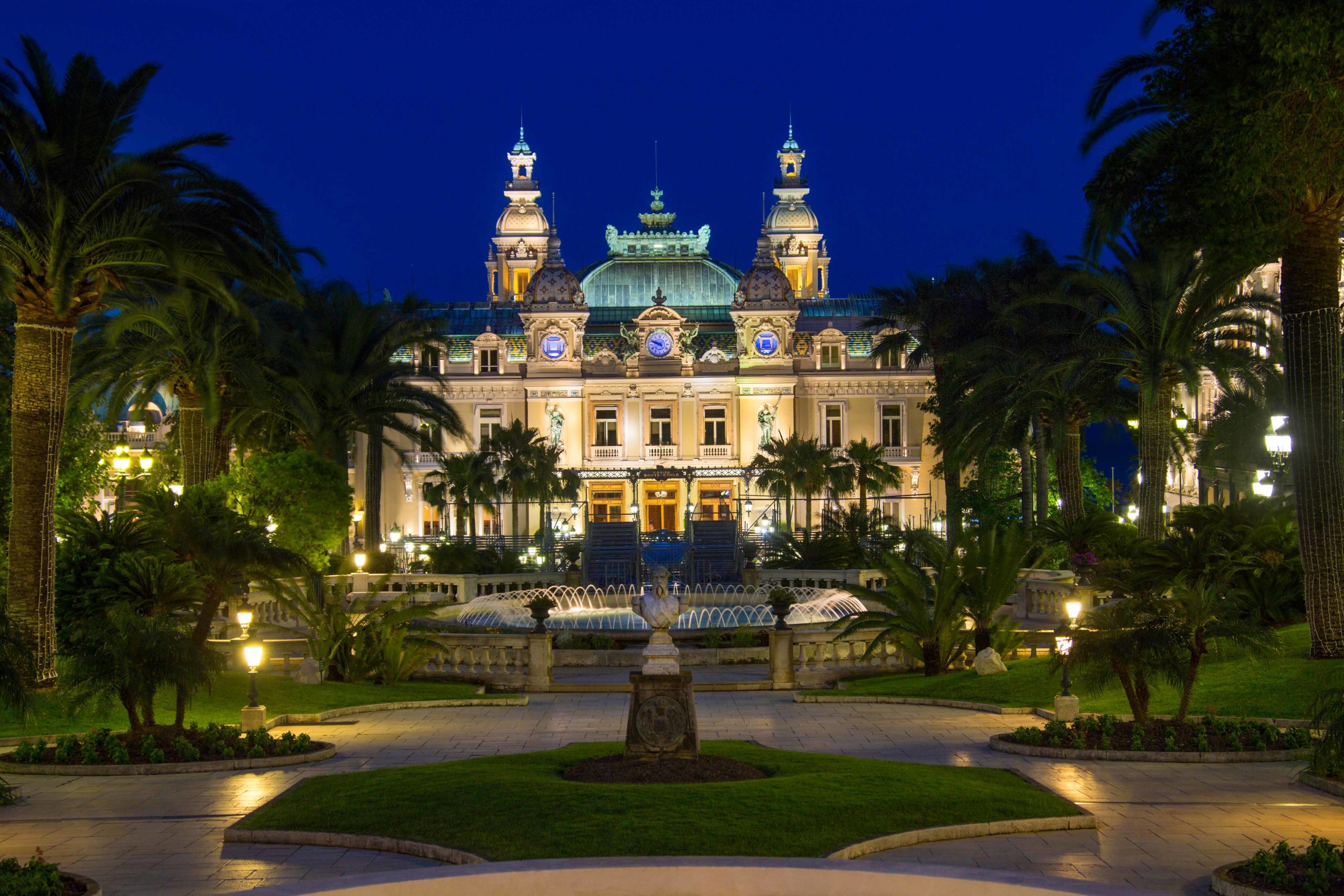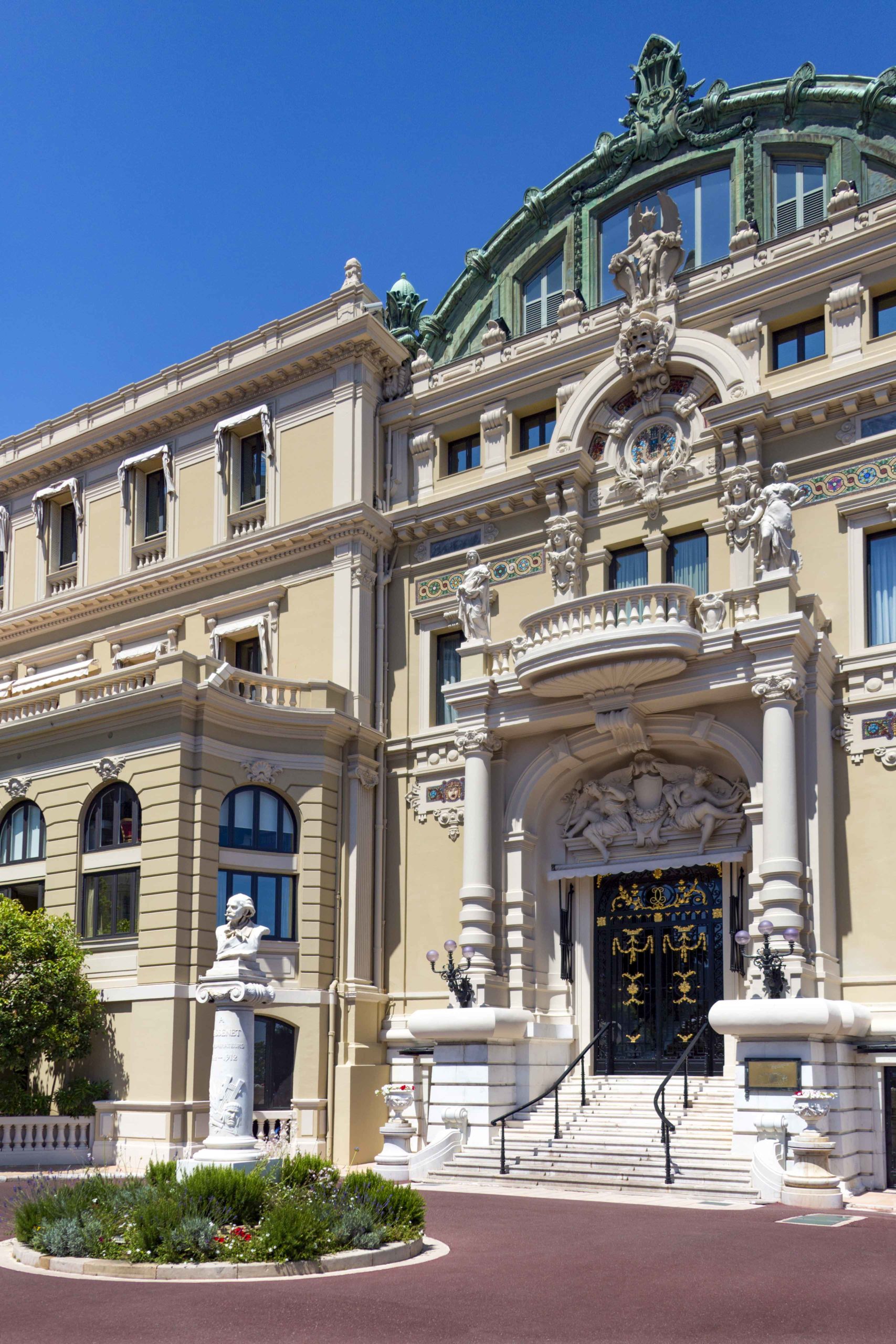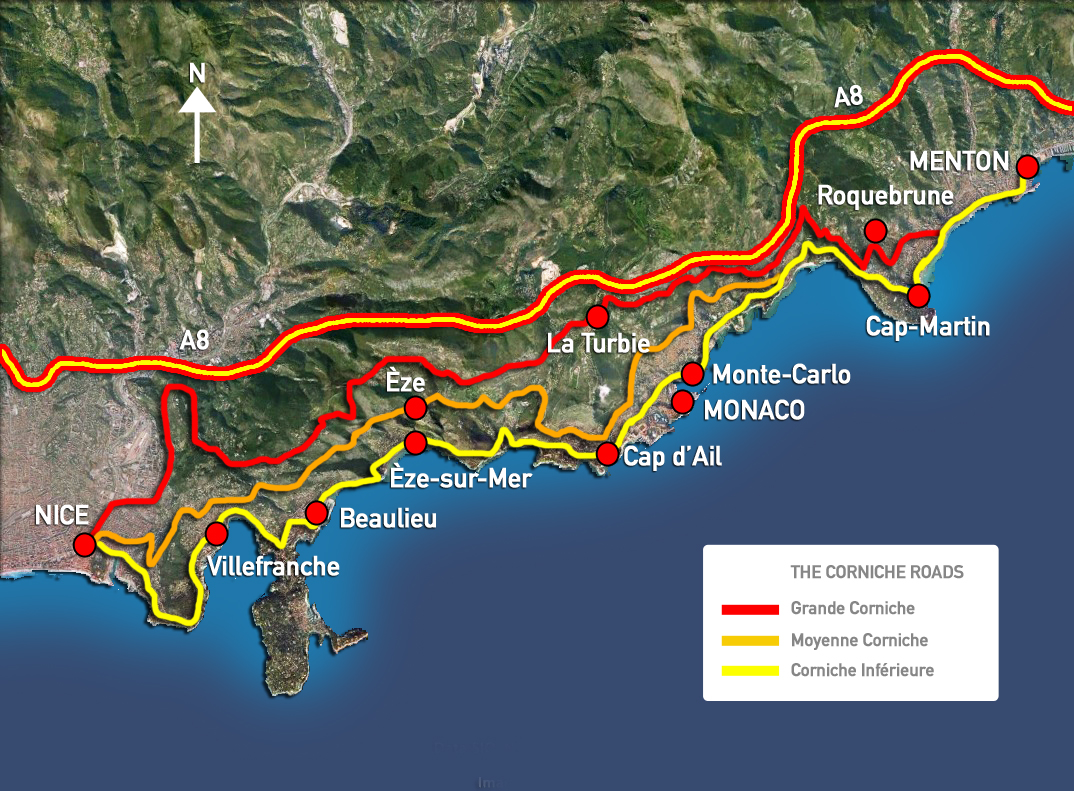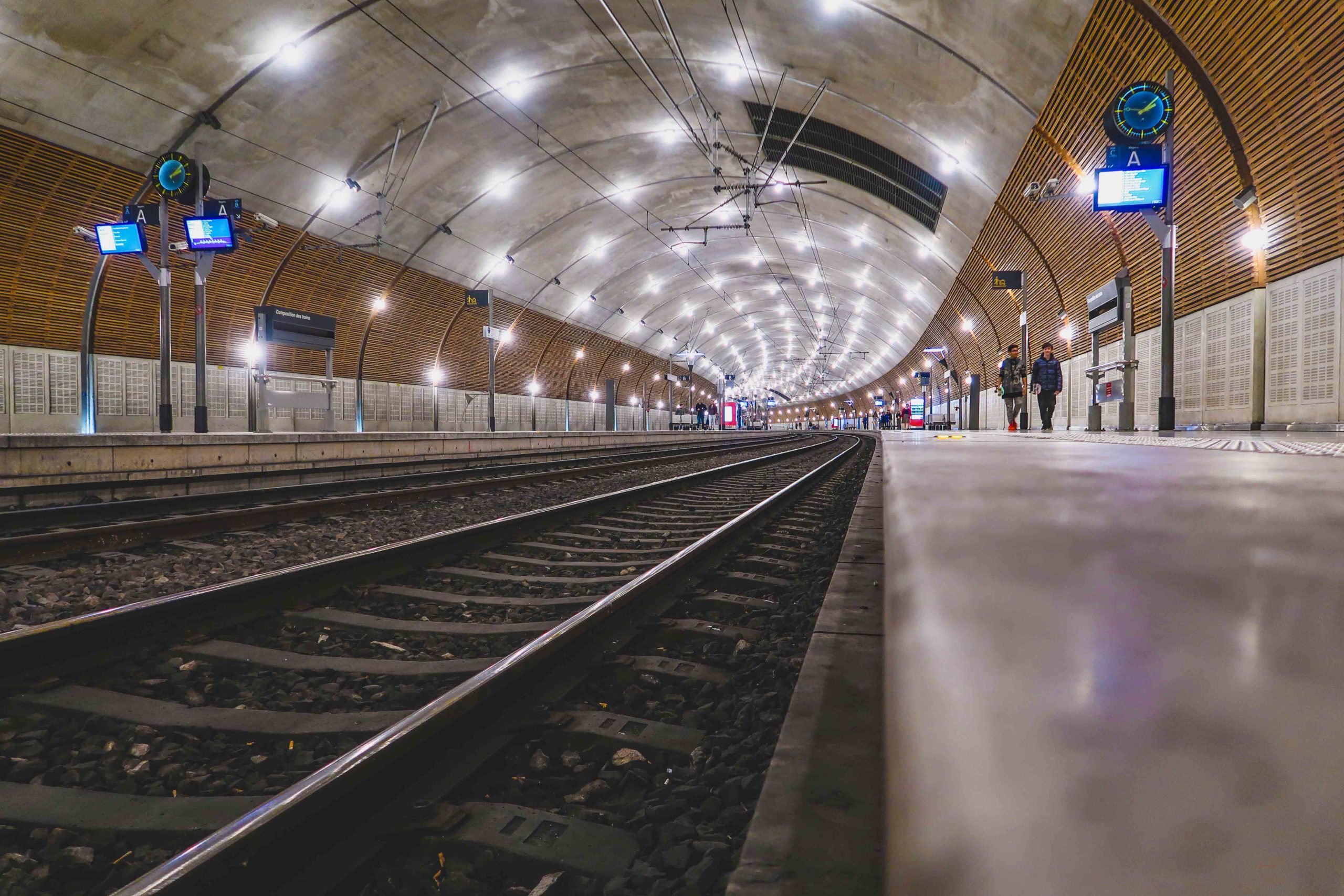Two names stand out in the glamorous and exclusive world of the French Riviera: Monaco and Monte Carlo. These two destinations are often used interchangeably, but are they the same? Of all the districts in the Principality of Monaco, Monte-Carlo is undoubtedly the most prestigious and chic, lively and residential. This is mainly due to the existence of the casino, a sumptuous monument reminiscent of the Belle Epoque. Let’s explore it together…
Watch our short video on Monaco: Facts & Figures!
Plan your trip to the Principality of Monaco
- 🏨 Find the best accommodations in Monaco on Booking.com
- 🙋♀️ Get the PASS CÔTE D’AZUR and take your pick from more than 100 unique experiences on the French Riviera!
- 🏛 Visit the Oceanographic Museum on the Rock of Monaco
- 🏰 Visit the Palais Princier (Prince’s Palace of Monaco) and buy your tickets online
- 🎯 Take a guided hidden gem tour of Monaco
- 🛥 Ride the Ferry from Nice to Monaco and back with this round-trip ferry transfer
- 🥗 Experience the culture and food of Old Nice on a 4-hour sightseeing and tasting tour
- 📚 Read the DK Eyewitness Provence and the Côte d’Azur Travel Guide
- 🤩 Get familiar with the French Riviera
- 🗺 Download the free City Map of Monaco
History of the Monte-Carlo District
In the mid-19th century, Prince Charles III sought financial resources for the Principality. In 1856 he decided to authorise the construction of a casino in Monaco.
How to bail out the Principality’s accounts!
In 1848, the Principality of Monaco lost Roquebrune and Menton, which was 80% of its territory. The two towns had emancipated themselves from Monaco under the protection of the Kingdom of Sardinia (these two towns subsequently became French in 1861).
![Menton © Claire2595 - licence [CC BY-SA 3.0] from Wikimedia Commons](https://frenchmoments.eu/wp-content/uploads/2014/08/Menton-©-Claire2595-licence-CC-BY-SA-3.0-from-Wikimedia-Commons.jpg)
This loss considerably impoverished the principality’s finances, particularly regarding agricultural income.
Then, Prince Charles III of Monaco decided to transform what remained of his principality into a resort and leisure centre designed to attract a wealthy foreign clientele.
In 1856, he authorised the opening of a casino to generate financial resources and put the Monegasque finances back on track. But this first attempt was unsuccessful: the concessionaires had a “bread-and-butter” mentality and lacked the scale for their projects, and all went bankrupt.

François Blanc to the rescue!
The casino built on the Spélugues plateau (Plateau des Spélugues) was a humble building isolated from the rest of the residential areas of Monaco. Indeed, no one wanted to buy a building plot in the vicinity.
To turn the situation around, Prince Charles turned to the man who had accumulated success in this field. That man then directed the casino in the German town of Bad Homburg (Hesse): François Blanc (1806-1877).

For 1.7 million francs and an annual sum of 50,000 francs plus 10% of the net profits, the Sovereign Ordinance of 2 April 1863 granted the French businessman and property developer the gaming concession for 50 years.
Then, in 1863, Charles III founded the Société des Bains de Mer (SBM) and entrusted the presidency to François Blanc.
Against all expectations, Blanc set his sights on the Spélugues Plateau (a hill deserted and isolated from Monaco) to set up his new establishment.
A success story
In just three years, constructing residences on the Spélugues Plateau around the casino became fashionable. Les Spélugues gave way to a new district built from scratch, dedicated to holiday and luxury, with its sumptuous buildings and villas.

On this site, Blanc founded the Hotel de Paris in 1864, as required by the specifications, inaugurated the casino in July 1865, as well as the sumptuous garden of the Casino square (with a water fountain and palm trees), and finally, the prestigious Café Divan (later Café de Paris) in 1868.
In addition, the completion of the Nice-Vintimille railway and the opening of the Monte-Carlo station in 1868 ensured the prosperity of this new place.
Thanks to his talents and his considerable capital, François Blanc succeeded in a very short time when his predecessors had gone broke.
Bingo: the casino and real estate speculation in Monte Carlo quickly made the enormous fortune of the Blanc and princely families. As a result, Charles III decided to abolish all tax collection in Monaco officially.
A necessary change of name
However, there was still a problem with the name of the new district of Monaco.
The word ‘Spélugues‘ means ‘caves‘. It derives from the Greek ‘σπήλαιον’=’spèlaion’, meaning ‘cave‘. And is found in the name of speleology.
But the plateau of Spélugues lent itself to the mockery of bad losers who associated it with Spelunke in German (a term designating a ‘dubious establishment’) or spélonque in Old French (a term designating a cut-throat).
Thus, Blanc advised Prince Charles III of Monaco to change this unconvincing name. Therefore, by order of 1 June 1866, the new Spélugues district was renamed Monte-Carlo (“Mont-Charles”) in honour of the Prince Charles III of Monaco (1818-1889).

Monte-Carlo: A District of Monaco
Monte-Carlo is part of the four traditional districts of Monaco, which are:
- Monaco-Ville: this is the old town built on the Rock
- La Condamine: around the Hercules port
- Monte-Carlo: a residential and hotel area famous for its glittering casino
- Fontvieille: a district reclaimed from the sea in 1971

- Monte-Carlo is the largest district in Monaco, covering 21.5% of the Principality’s surface area.
- In addition, 22% of the population resides in the district, compared to only 3% in the Rock (old town).
Since 1966, Monaco has been divided into ten smaller districts. In turn, the traditional district of Monte-Carlo comprises four areas:
- Larvotto
- Monte-Carlo
- La Rousse
By 2025, Monte-Carlo will be extended with the inauguration of a new and fourth district: Le Portier.

Decoding the Difference: Monaco vs Monte Carlo
What’s the difference between Monaco and Monte Carlo?
Nestled along the Mediterranean coastline, Monaco is the second-smallest country in the world. Known for its opulence, it has long been a playground for the rich and famous. On the other hand, Monte Carlo is one of Monaco’s four quarters, renowned for its luxurious casino and world-class entertainment. While Monaco encompasses more than Monte Carlo, the latter has become synonymous with wealth, high-stakes gambling, and extravagance.
Unravelling the nuances between Monaco and Monte Carlo is essential for any traveller exploring this enchanting destination. From the grandeur of Casino de Monte-Carlo to the Old Town charm of Monaco-Ville, each offers a unique experience filled with rich history, stunning architecture, and breathtaking views.
In addition, Monte Carlo is the most famous district of Monaco, so much so that it is sometimes confused with the whole country or wrongly considered as its capital or as a second municipality within the Principality.
Look at the number plates of cars in the principality. They display the letters “MC”, which seems to refer to Monte-Carlo, whereas this is an abbreviation of Monaco.
However, RMC (Radio Monte-Carlo) takes its name from the district, not the country.
A distinction must be made for motor racing between the Grand Prix Automobile de Monaco and the Rallye Automobile Monte-Carlo.
Beausoleil, a French suburb of Monaco
The rapid urbanisation of Monte-Carlo led to creating an actual “suburb” on French territory. This land was part of the lower districts of the French commune of La Turbie.
The law of 10 April 1904 created a new commune distinct from La Turbie under the name of Beausoleil.
Monte-Carlo’s not-to-miss sites
Monte Carlo’s central location is the Place du Casino, a vibrant and animated square bordered by three iconic buildings: the Monte Carlo Casino, the Café de Paris and the Hotel de Paris.
![Monte-Carlo Place du Casino © Laura Caillebot - licence [CC BY 2.0] from Wikimedia Commons](https://frenchmoments.eu/wp-content/uploads/2014/08/Monte-Carlo-Place-du-Casino-©-Laura-Caillebot-licence-CC-BY-2.0-from-Wikimedia-Commons-scaled.jpg)
The Casino of Monte-Carlo

Lying at the heart of Monte-Carlo is the prestigious Casino de Monte-Carlo, a gambling and entertainment complex built by Charles Garnier and opened in 1879. With its gilded pillars and frescoed ceilings, the casino draws a large crowd of celebrities, one of its most famous clients being… Bond, James Bond!
History of the Monte-Carlo Casino
In 1878, Marie Blanc, the wealthy widow of François Blanc (who died in 1877), asked the Parisian architect Charles Garnier to build the Monte Carlo Opera House. The construction site, a great attraction for the onlookers, started in May 1878 and lasted only six months. Four hundred workers worked day and night thanks to electric projectors invented by a Russian general.

The inauguration occurred on 25 January 1879, and Sarah Bernhardt was the first celebrity to walk the stage and perform a poem.
The Casino de Monte-Carlo was then enlarged several times until 1910 (Touzet lounges and a front facade in 1889-1890 by Charles Touzet), when it took on its current form.

The casino was the source of Monaco’s fortune, which Charles III and his successors (Albert I, Louis II, Charlotte, Rainier III and Albert II) were able to increase tenfold through real estate, banking and financial speculation. Today, its annual turnover represents only a tiny part of the income of the principality and the Grimaldi family.
![Casino of Monte Carlo by night © Casal Partiu - licence [CC BY-SA 2.0] from Wikimedia Commons](https://frenchmoments.eu/wp-content/uploads/2022/09/Monaco-Monte-Carlo-by-night-©-Casal-Partiu-licence-CC-BY-SA-2.0-from-Wikimedia-Commons.jpg)
Visit the casino
Following a guided tour leading to private rooms is the best way to discover the Casino de Monte-Carlo.
The European rooms have poker/slot machines, French roulette and trente et quarante (a card game), while the Private Rooms offer baccarat, blackjack, craps and American roulette.

The Salon Europe dates back to 1865 and is the oldest part of the casino. It features onyx columns and eight Bohemian crystal chandeliers weighing 150 kg each!
Female gamblers inspired the decoration of the Salle Blanche (1903). Henri Schmidt decorated it with the painting Les Grâces Florentines and caryatids with their wings spread for flight. They illustrate the emerging emancipation of women.
The immense and grand Salle Medecin (or Salle Empire) was opened in 1910. The room featured extravagant decor initially intended for the casino’s biggest gamblers. However, today you won’t see them as they are taking refuge in one of the three adjoining exclusive private rooms.
![Casino de Monte Carlo Salle de Jeu © Matthew Hartley - licence [CC BY-SA 2.0] from Wikimedia Commons](https://frenchmoments.eu/wp-content/uploads/2014/08/Casino-de-Monte-Carlo-Salle-de-Jeu-©-Matthew-Hartley-licence-CC-BY-SA-2.0-from-Wikimedia-Commons-scaled.jpg)
Please note that the dress code is rigid: jackets and ties are required in the private gaming rooms and after 8 pm in the casino. In addition, entrance is forbidden for children under 18 years old.
Why don’t Monegasques have the right to enter the casino?
Prince Charles III feared his subjects would squander their meagre resources on gambling. Therefore, he forbade them to gamble in the principality’s casino. A law reinforced this provision passed in 1987 and is still in force. Thus, an identity card is still required today in the principality’s gaming establishments so that the player can collect his winnings, which Monegasque citizens systematically refuse.
This ban has another advantage. Indeed, it prevents local croupiers from being confronted with clients who are members of their family or circle of friends and therefore be tempted to commit fraud.
Trivia: gambling at the casino was uninterrupted despite two World Wars… until the 2020 Pandemic stroke!

Opera House
The Monte-Carlo Opera House, or Salle Garnier, is an auditorium adjacent to the Monte-Carlo Casino.

The opera house and the new casino were designed by the architect Charles Garnier under the impulse of Marie Blanc (widow of François Blanc). They were inaugurated on 25 January 1879 on the occasion of a performance by Sarah Bernhardt.
The Salle Garnier, an Italian-style theatre, is a miniature replica of the Paris Opera with its bas-reliefs, red and gold sculptures, ceiling frescoes, and a magnificent crystal chandelier.


The entrance and atrium
The entrance to the casino, built in 1893, gives access to the opera house.

The atrium is paved with marble and has 28 onyx Ionic columns.
![Casino de Monte Carlo Atrium © Larry Koester - licence [CC BY 2.0] from Wikimedia Commons](https://frenchmoments.eu/wp-content/uploads/2014/08/Casino-de-Monte-Carlo-Atrium-©-Larry-Koester-licence-CC-BY-2.0-from-Wikimedia-Commons.jpg)
The opera’s terrace offers a splendid view of the Mediterranean coastline from the promontory rock of Monaco to Bordighera in Italy.
Please note that entry to the casino and opera house is not permitted for people in shorts, t-shirts and sweatshirts. Men must wear a blazer/suit jacket. Dark jeans and smart casual shoes are tolerated. Evening dresses are recommended for women.

The Casino Gardens
The casino management of the time, in agreement with Prince Charles III, entrusted Edouard André (1840-1911) with the creation of the gardens, which combine the main lines of the “French” gardens with the undulations, waterfalls, streams and basins of the landscape style, impregnated with a characteristic exotic note. In fact, Edouard André used the natural slope to create a cascade stream, ending at the lowest point with a large pool.

The fashionable theories about the French Riviera-inspired the French landscape gardener. Indeed, the region was considered a scorching country that could only be inhabited in winter. The gardens gave the impression of a fiery, tropical flora, of an eternal spring from December to March. Part of the Jardins du Casino is called “Little Africa”. Among the remarkable species in the garden are Ficus macrophylla, Erythrina crista-galli, Chorisia speciosa, Lagunaria, Casuarina, Metrosideros, Musa, and Strelitzia augusta.



Café de Paris
The Café de Paris de Monte-Carlo is a legendary Belle Époque-style café-restaurant from the 1900s. It also serves as a casino adjacent to the Casino de Monte-Carlo.
![Monte-Carlo Café de Paris © Benoît Prieur - licence [CC0] from Wikimedia Commons](https://frenchmoments.eu/wp-content/uploads/2014/08/Monte-Carlo-Café-de-Paris-©-Benoît-Prieur-licence-CC0-from-Wikimedia-Commons-scaled.jpg)
The café was founded in 1868, at the same time as the Casino de Monte-Carlo and the Hôtel de Paris. Under the impetus of François Blanc and Prince Charles III of Monaco, it was initially named “Café Divan”. It was transformed several times until the 1930s, then completely renovated in 1988 in the Belle Époque style of the 1900s in the image of old Parisian bistros.
![Monte-Carlo Café de Paris © Benoît Prieur - licence [CC0] from Wikimedia Commons](https://frenchmoments.eu/wp-content/uploads/2014/08/Monte-Carlo-Café-de-Paris-Entrance-©-Benoît-Prieur-licence-CC0-from-Wikimedia-Commons-scaled.jpg)
The Casino offers over 13,000 m² of gaming rooms in a decor inspired by the Historic Grand Prix of Monaco with over 450 slot machines, Video Poker, American Roulette, Black Jack and Craps.
Hôtel de Paris
The Hôtel de Paris is a prestigious ***** star palace founded by Prince Charles III of Monaco and François Blanc, based on the plans of the French architect Godinot de la Bretonnerie. The hotel was inaugurated in 1864 in the casino area.
![Hotel de Paris © Jordiferrer - licence [CC BY-SA 4.0] from Wikimedia Commons](https://frenchmoments.eu/wp-content/uploads/2014/08/Monte-Carlo-Hotel-de-Paris-©-Jordiferrer-licence-CC-BY-SA-4.0-from-Wikimedia-Commons-scaled.jpg)
The Belle Epoque façade by the architect Édouard-Jean Niermans dates from 1909-1910 and includes frescoes by the painter Paul Gervais.
The vast entrance hall houses an equestrian statue of King Louis XIV, whose horse’s shiny right knee is said to bring good luck to those who rub it.
There are prestigious lounges: “Charles III”, “Debussy”, and “Berlioz”, beautifully decorated.

The hotel has 113 rooms, including the “Rainier III” suite on the roof. Like the “Princess Grace Suite”, the latter was created during the hotel’s last renovation. Decorated with furniture from the Prince’s Palace of Monaco, they account for 25% of the 2020 turnover (a night costs between 30,000 and 45,000 euros).
The hotel houses three restaurants, including “Le Louis XV”, a 3-star Michelin restaurant by chef Alain Ducasse. The hotel’s private wine cellar is one of the largest in the world, with nearly 550,000 bottles in 200,000 m².
Fancy an unforgettable night at the Hôtel de Paris*****? Book your room here!
![Hotel de Paris © Arnaud 25 - licence [CC BY-SA 4.0] from Wikimedia Commons](https://frenchmoments.eu/wp-content/uploads/2014/08/Monte-Carlo-Hotel-de-Paris-©-Arnaud-25-licence-CC-BY-SA-4.0-from-Wikimedia-Commons.jpg)
The Carré d’Or
The most prestigious part of Monte-Carlo is called the “Carré d’Or” (Golden Square).
The Carré d’Or is built around the Place du Casino and its magnificent landscaped gardens, with beautiful trees, ponds…
But this prestigious district also includes fabulous boutiques, luxury brands and shopping arcades worthy of the most beautiful capitals in the world. One of them, the Metropole Shopping Monte Carlo, is exceptional: beautiful ready-to-wear brands, luxurious jewellery, tea rooms and restaurants with refined cuisine…
![Le Métropole Shopping Centre © Leandro Neumann Ciuffo Villa Sauber - licence [CC BY 2.0] from Wikimedia Commons](https://frenchmoments.eu/wp-content/uploads/2014/08/Monaco-Le-Métropole-©-Leandro-Neumann-Ciuffo-Villa-Sauber-licence-CC-BY-2.0-from-Wikimedia-Commons.jpg)
The Carré d’Or is also home to Michelin-starred restaurants such as Alain Ducasse’s Louis XV, Vistamar and chef Joël Robuchon’s restaurant at the Metropole. But the Carré d’Or is also famous for its trendy and festive restaurants, such as the Buddha Bar, the Rampoldi and the Fairmont Hotel, located on the world-famous Monaco Grand Prix hairpin bend.
Boulevard des Moulins
Most of Monaco’s luxurious shops are found along Boulevard des Moulins, selling jewels, clothes, designer luggage and luxury cars.

Villa Sauber
Just a few metres from the Carré d’Or is the Villa Sauber, which belongs to the Larvotto district.
![Monte-Carlo Villa Sauber © Mister No - licence [CC BY 3.0] from Wikimedia Commons](https://frenchmoments.eu/wp-content/uploads/2014/08/Monaco-Villa-Sauber-©-Mister-No-licence-CC-BY-3.0-from-Wikimedia-Commons-scaled.jpg)
It is a Belle Époque villa in Monaco. It first belonged to the Blanc family, who contributed to the development of the Société des Bains de Mer and the Casino de Monte-Carlo.
The villa shares similarities with the Opera House, built at the same time by Charles Garnier. It has, therefore, often been assumed that the famous Parisian architect built the Sauber villa.
In 1904, the British painter and illustrator Robert Sauber (1868-1936) bought the villa from Edmond Blanc. The painter set up his studio in the west wing of the estate. From then on, Robert Sauber and his wife kept the house and called Villa Sauber for ten years. They sold it shortly before the First World War outbreak in 1914. It passed through several hands before the Saubers repurchased it in 1925. In the early thirties, the Saubers, then elderly, bequeathed the Villa to the London Police Courts Relief Fund, which retained ownership of the Villa for some fifteen years.
In 1969, the Sauber property was bought by the Société immobilière Domaniale de Monaco. Today, the villa belongs to the Monegasque State. This architectural jewel has become the new National Museum of Monaco. The villa and its garden are now open to the public.
Find out more on the official website of Villa Sauber
More practical info about Monte-Carlo

Pin in on Pinterest
Did you enjoy the reading? If so, please pin these images on Pinterest, or share this article on Facebook and Twitter! 😊


What to do in Monaco?
Want to know what you can do in and around Monaco? Click on the image below for a list of activities:
From Private Guided Walking Tour to Lamborghini Driving Experience and French Riviera Cruises, the Principality dazzles with glamorous activities you won’t forget. Here’s a little list of what’s on offer!
Where to stay in Monaco?
Did you know? There are 12 hotels in the Principality, four ***** and four ****. Unsurprisingly, accommodation in the Principality is costly. Unless you want to stay within the Principality, there is a cheaper alternative. You should look at the Beausoleil district in France, a few minutes walk from the Monaco train station. Prices are much more affordable than in Monaco.
Click here to choose your accommodation in Monaco and its surroundings, or browse the map below:
How to get to the Principality of Monaco

Arriving by car
Monaco is accessible from Nice via the scenic coastal Corniche roads:
- the Corniche Inférieure road follows the coast via Beaulieu,
- the Moyenne Corniche passes through Èze,
- and the Grande Corniche crosses La Turbie.

The Principality is bordered by the French A8 motorway linking Provence to Italy. Paris is 950 km away via the A6, A7 and A8 motorways.
Thanks to the A8 motorway, you can reach the centre of Monaco in less than 30 minutes from Nice and its airport.
- Exit 56 “Monaco” in the direction of France -> Italy
- Exit 58 “Roquebrune Cap Martin” in the direction of Italy -> France
However, please note that access to Monaco-Ville (Le Rocher) is limited to users whose vehicle is registered in Monaco and the French département of Alpes Maritimes [06].
How to park in Monaco
Other vehicles should park in the Parking des Pêcheurs, which has pedestrian access to the Rock in a few minutes.
Leaving your vehicle in one of the many public car parks is advisable. The Principality has no less than 40 car parks with 15,500 spaces.
All the car parks are underground, guarded and secure. They are, therefore, the best solution for parking your vehicle. All public “Monaco Parking” offers free parking for 1 hour. For more information, visit the official website of the Monaco Carparks.
Nearest Airport
Nice-Côte d’Azur International Airport links the Principality of Monaco to more than 86 destinations worldwide.
Through Nice Airport (25 minutes away by motorway), Monaco is linked daily to the main European capitals and, beyond, to all continents.
Air France offers 73 flights a day to Nice Airport, directly from 15 cities in France and seven cities worldwide.
Moreover, the airport is 7 km away by helicopter to the Monaco heliport in the Fontvieille district.
Monaco Train Station
Monaco is located on the Marseille-Ventimiglia railway line. The underground SNCF station at Monaco-Monte-Carlo, offers daily TGV services to Paris, and up to ten other cities, via the nearby Nice-Ville station.
TER trains link Monaco to Menton and Ventimiglia to the north-east, Nice, Antibes, Cannes, Grasse and Saint-Raphaël to the south-west.
In addition, there are several daily connections to Turin, Milan and Rome via Ventimiglia.

Six entrances allow users to access the underground railway station via a series of escalators or lifts:
Sainte Dévote Bridge, Parvis de la Gare (behind Sainte Dévote Church), Port Hercule, Jardin Exotique, Allée Lazare Sauvaigo/Rue Grimaldi/Rue Suffren-Reymond, Avenue Prince Pierre.
English-French Vocabulary
(f) for féminin, (m) for masculin, (adj) for adjective and (v) for verbs
- Alps = Alpes (f,p)
- casino = casino (m)
- French Riviera = Côte d’Azur (f)
- harbour = port (m)
- hotel = hôtel (m)
- marina = port de plaisance (m)
- Maritime Alps = Alpes Maritimes (f,p)
- Mediterranean Sea = Mer Méditerranée (f)
- micro-state = micro-état (m)
- opera = opéra (m)
- Principality = Principauté (f)
- port = port (m)

Featured image: The famous Monte Carlo Casino. Photo: @SteveAllenPhoto via Twenty20




